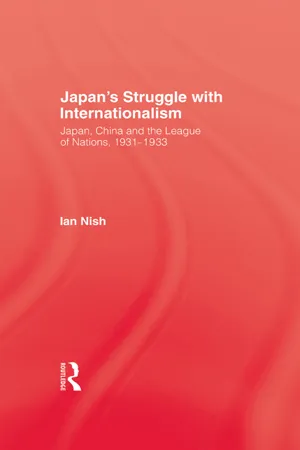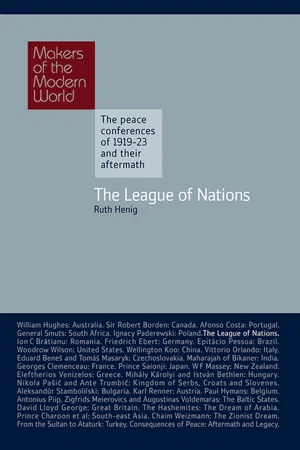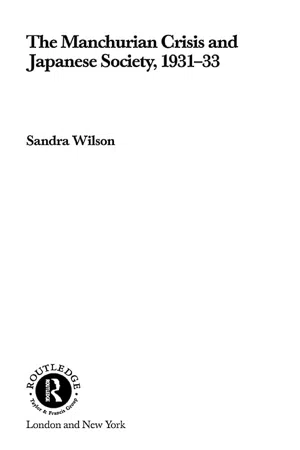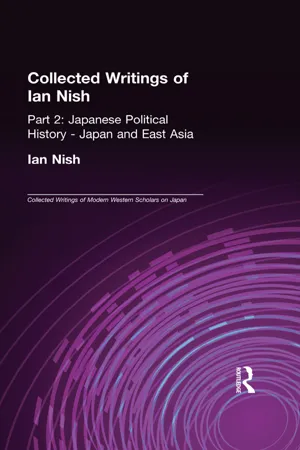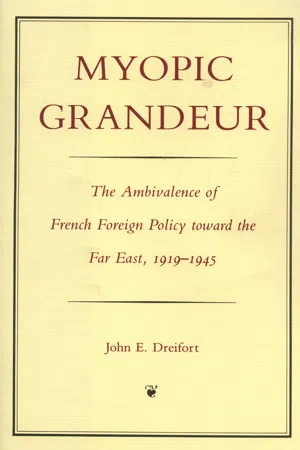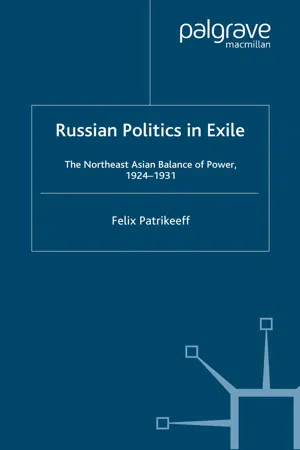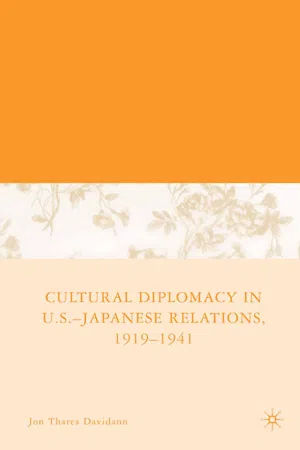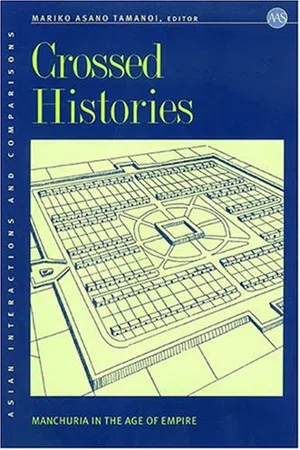History
Manchurian Crisis
The Manchurian Crisis, also known as the Mukden Incident, occurred in 1931 when the Japanese Kwantung Army staged a bombing of a railway in Manchuria, China, as a pretext to invade and occupy the region. This event led to international condemnation and the League of Nations' failed attempts to resolve the conflict, ultimately highlighting the organization's ineffectiveness in preventing aggression.
Written by Perlego with AI-assistance
Related key terms
1 of 5
12 Key excerpts on "Manchurian Crisis"
- eBook - ePub
- Ian Nish, Nish(Authors)
- 2012(Publication Date)
- Taylor & Francis(Publisher)
5 The Shanghai Crisis, January-March 1932The Manchurian Crisis came to be merged with the Shanghai crisis from January 1932 onwards and created a major international problem. Of course, foreign countries were not in the main strongly committed to Manchuria which was seen as a distant land where the issues involved were obscure. Those people most worried over Manchuria were largely concerned with political principles, because of violations of the League covenant or of the Pact of Paris or because of the failure of collective security. Japanese nationalists were inclined to react rather irritably that interference by foreigners on such grounds was ‘none of their business’. This is reflected in Professor Akagi’s words when he wrote from Dairen that the League sessions on Manchuria ‘became memorable, not in settling the crisis, but rather in deepening the deadlock between Japan and China.’1When the focus of world attention turned to Shanghai, the situation changed. The Sino-Japanese dispute took on a new immediacy. Foreign countries, notably the United States and the United Kingdom, had for most of the past century been engaged there commercially and politically. Their national interest was caught up in the developing crisis. In addition, it may be argued that, when the Shanghai turmoil developed, Manchuria took on a new significance which had not been realized hitherto. The powers tended to see convergence and linkage between the two regional crises. Japan disputed this, seeing the issues involved in Manchuria as quite different from those at Shanghai. It became Japan’s case that Shanghai was an international problem in which she was not the only sufferer, that foreign powers with interests in Shanghai had needs similar to herself, namely the protection of their nationals and the security of their businesses, and that they should be making common cause with her.Japanese were by 1932 very numerous in Shanghai. Out of one million residents in the International Settlement, it is estimated that 25,000 were Japanese, compared to 6,000 British. Considering that many foreigners lived outside the Settlement, the numbers may have been larger than these figures suggest. It seems that the situation of Japanese in Shanghai had deteriorated considerably in that the boycott of Japanese goods had been effective since 1926 and had cut deep since the Manchurian Crisis began. Many Japanese cotton mills throughout the International Settlement and Greater Shanghai had been forced to close and their operatives had been thrown out of work. The area had become full of unemployed coolies who bore a grudge against the Japanese. By January 1932 the atmosphere in the city was explosive. - eBook - PDF
The Manchurian Myth
Nationalism, Resistance, and Collaboration in Modern China
- Rana Mitter(Author)
- 2000(Publication Date)
- University of California Press(Publisher)
4 INTRODUCTION Japanese historiography, which feed into much larger questions of war guilt and left-right divisions that still scar Japanese society, make the topic of Japan’s imperial past difficult for that country to deal with. 4 This study cannot claim to solve these problems, but it aims to con-tribute to a more nuanced and less politically charged analysis of the meaning of Manchukuo. The Manchurian Crisis This book deals with the first phase of the Manchurian Crisis, from the occupation of southern Manchuria in 1931 to the signing of the Tanggu Truce in 1933. This was the period during which the groups touched by the crisis made their most important decisions about what was to happen to the Northeast; they included the Chinese gov-ernment, the Japanese army and government, the League of Nations and the western powers, and, as this study stresses, the Chinese inhabi-tants of the region themselves. As this study is thematic rather than chronological in its treatment, a short narrative summary of the events of the crisis during this period is provided here. Shortly after 10:30 P . M . on 18 September 1931, a bomb exploded on a railway line outside the city of Shenyang (often referred to in Western reports of the time by its old Manchu name of Mukden), the regional capital of northeastern China. The Japanese Kwantung Army garrison, directed by two junior officers, Ishiwara Kanji and Itagaki Seishir o , claimed that Chinese soldiers had set off the explosion, intending to wreck a Japanese train that was due on that section of the line. The army then used this event as a pretext to launch a full-scale occupation of much of southern Manchuria. 5 In fact, the Manchurian Incident had been engineered by Ishiwara, Itagaki, and the men under their com-mand. The occupation, which was carried out in a matter of days, took the government in Tokyo under the liberal prime minister Wakatsuki Reijir o by surprise. - eBook - ePub
The Peace That Never Was
A History of the League of Nations
- Ruth Henig(Author)
- 2019(Publication Date)
- Haus Publishing(Publisher)
6The Manchurian Crisis, 1931–3
On the evening of 18 September 1931, an explosion occurred on the Japanese-run South Manchurian Railway, just north of Mukden. The track was not greatly damaged – a train bound for Mukden passed safely over the spot shortly afterwards – but the incident resulted in the mobilisation of Japan’s troops in Manchuria, skirmishes with Chinese troops around Mukden, and attacks on key points in the vicinity. Within days, Japanese army units had fanned out across South Manchuria and on 8 October, 11 Japanese planes attacked Chin-chow, well down the track on the way to Beijing.Three days after the explosion, on 21 September, the Chinese appealed both to the League under Article 11 and to the United States under the Kellogg-Briand Pact to take action to stop the fighting. While it was not immediately clear either in Geneva or in Washington whether the Japanese or the Chinese were to blame for the outbreak of violence, there was general agreement that the crisis needed to be speedily resolved.On 30 September, the League Council accepted the reassurances of the Japanese delegate that Japan had no warlike intentions in Manchuria and no territorial designs and that her troops would soon be withdrawn back to the railway zone, and of the Chinese delegate that Japanese lives and property in Manchuria would be safeguarded, and adjourned consideration of the dispute for two weeks.League members had far more weighty matters on their minds in September 1931 than military skirmishes between Japanese and Chinese troops in distant Manchuria. The British government had just come off the gold standard, and was in the process of forming a national government. Political events in Germany, with the explosive growth of both right-wing nationalism and communism, were profoundly worrying. European countries and the US government were locked in acrimonious discussions about the possibilities of reducing or postponing reparation and war debt payments. And energies at Geneva were being consumed by preparations for a disarmament conference and for talks to try to promote collective economic action to counteract the deadly impact of the depression. - eBook - ePub
- Ruth Henig(Author)
- 2010(Publication Date)
- Haus Publishing(Publisher)
6The Manchurian Crisis, 1931–3
On the evening of 18 September 1931, an explosion occurred on the Japanese-run South Manchurian Railway, just north of Mukden. The track was not greatly damaged – a train bound for Mukden passed safely over the spot shortly afterwards – but the incident resulted in the mobilisation of Japan’s troops in Manchuria, skirmishes with Chinese troops around Mukden, and attacks on key points in the vicinity. Within days, Japanese army units had fanned out across South Manchuria and on 8 October, 11 Japanese planes attacked Chinchow, well down the track on the way to Beijing.Three days after the explosion, on 21 September, the Chinese appealed both to the League under Article 11 and to the United States under the Kellogg-Briand Pact to take action to stop the fighting. While it was not immediately clear either in Geneva or in Washington whether the Japanese or the Chinese were to blame for the outbreak of violence, there was general agreement that the crisis needed to be speedily resolved.On 30 September, the League Council accepted the reassurances of the Japanese delegate that Japan had no warlike intentions in Manchuria and no territorial designs and that her troops would soon be withdrawn back to the railway zone, and of the Chinese delegate that Japanese lives and property in Manchuria would be safeguarded, and adjourned consideration of the dispute for two weeks.League members had far more weighty matters on their minds in September 1931 than military skirmishes between Japanese and Chinese troops in distant Manchuria. The British government had just come off the gold standard, and was in the process of forming a national government. Political events in Germany, with the explosive growth of both right-wing nationalism and communism, were profoundly worrying. European countries and the US government were locked in acrimonious discussions about the possibilities of reducing or postponing reparation and war debt payments. And energies at Geneva were being consumed by preparations for a disarmament conference and for talks to try to promote collective economic action to counteract the deadly impact of the depression. - Sandra Wilson(Author)
- 2003(Publication Date)
- Routledge(Publisher)
hijōji). In fact, this pervading sense of crisis is arguably the chief factor that marks and gives unity to the early 1930s. Some ideologues also worked hard to present 1931 as the beginning of a spiritual revival of the Japanese people. In that sense, the idea that the Manchurian Incident marked the beginning of a new era, which we have noted in a historiographical context, has a long history.The extremely vague concept of ‘national crisis’ was not new in the 1930s. Carol Gluck observes, for example, that ideologues in the late nineteenth and early twentieth centuries were ‘impelled almost always by an acute sense of crisis’.102 Thus there was a familiar vocabulary to draw upon, but at the same time the ‘crisis’ of the early 1930s was understood in terms quite specific to that period. As in inter-war Germany, ‘a complex sense of crisis’103 emerged in Japan in the early 1930s, to be reinforced in the press and by the authorities. This sense of crisis was produced above all by a widening consciousness of the depth of the depression and of rural distress especially, often coupled with a perception that the problems were of such magnitude as to defy standard relief measures. It was stimulated by the increasing publicity given to the threat posed to Japanese interests in China by the growing Chinese nationalist movement, and then by the Manchurian Incident itself and subsequent dealings with the Western powers. The Shanghai Incident brought further condemnation from the Western powers, while the 15 May Incident of 1932 and the end of party cabinets provided a specifically domestic and political dimension to the sense of crisis, along with the mounting calls for rural relief. The October 1932 report by the League of Nations into the Sino-Japanese dispute, interpreted as unfavourable to Japan, prolonged the ‘diplomatic’ aspect of the crisis, which continued to be given prominence in the press and elsewhere until Japan’s departure from the League early in 1933.104- eBook - ePub
- Gordon Martel(Author)
- 2002(Publication Date)
- Routledge(Publisher)
By beginning their narratives after 1933, these works suggest that the “success” of the Manchurian campaigns bore no relation to the failures of the China Incident. 26 And yet, the facility with which Japan occupied Manchuria nurtured the hubris of Japanese ambitions to crush the Nationalists in a quick and decisive strike, and fed mounting ambitions to absorb all of China’s vast territories. Moreover, both incidents arose from the contradiction between Japanese imperialism and Chinese nationalism, and what Japanese military planners were blind to in both 1931 and 1937 was that the Nationalist movement could not be vanquished by military means. The occupation of Manchuria was an enormous stimulant to Chinese nationalism and steeled Chinese determination to resist Japan at all costs. As much as it reflected Japanese overconfidence, this determination to resist was the product also of the Manchurian Incident, and both attitudes helped precipitate the outbreak of fighting on the Marco Polo Bridge in 1937 and its escalation into all-out war. Much like the analysis of the Manchurian and China Incidents, the histories of the other fronts in the Second World War in Asia are contained in separate literatures, each highlighting its distinctive origins and character. 27 The conflict with the Soviet Union that flared into the series of Manchukuo–Siberian border wars in 1937–39 was justified by a combination of Russophobia and anti-Communism. Though fears of the “red peril” emerged powerfully in the wake of the Russian Revolution and the failure of Japan’s military efforts to contain communism in the Siberian Expedition of 1918–22, Russophobia had deeper roots, going back to the competition over Korea and Manchuria that culminated in the Russo-Japanese War of 1904–5. When the Japanese occupied the Russian sphere of influence in north Manchuria in the early 1930s, they destroyed the geopolitical balance of power that had been laid down in 1905 and had lasted for twenty-five years - eBook - ePub
Collected Writings of Ian Nish
Part 2: Japanese Political History - Japan and East Asia
- Ian Nish(Author)
- 2014(Publication Date)
- Routledge(Publisher)
Part III The Manchurian Crisis and AfterPassage contains an image
17 An Overview of Relations between China and Japan, 1895–1945THE RELATIONSHIP between China and Japan is a many-layered cake, impossible to eat all at once. This article will concentrate on the diplomatic layer of the relationship. Diplomatic history is essentially about the decisions of governments and the documents that are subsequently exchanged. Each of these aspects has its difficulties for the historian of East Asia. For substantial parts of the period under review ‘government’ in a western sense hardly existed in China, while in Japan even the considered decisions of the government in Tokyo frequently failed to reflect the situation on the ground. In Japan’s relations with China there was often a dual – if not a multiple – diplomacy at work where the army (among others) had an independent hand in fashioning ‘policy.’The ‘documents’ for Sino-Japanese relations also present a problem for the historian. China and Japan waged psychological warfare for most of the period between 1905 and 1945. This often took the form of a propaganda war, partly to capture the hearts of the people in the other country but also partly to influence public opinion in their own. In the case of the English-language exposition of policy in which both China and Japan indulged to a great extent, the intention was to capture the hearts of third parties and persuade them to take sides. In Japan this propaganda often took the form of pan-Asian doctrines. Probably no Japanese government explicitly embraced these doctrines, but there were groups close to the reins of power which subscribed to them. Pan-Asianism held little attraction for the Chinese (at least as it was formulated by Japan) and did not form part of their policy statements.Any overview of Sino-Japanese relations should pinpoint the key dates, which, in the period under review, occurred in 1911–12, 1927–28 and 1937. Accordingly this article is divided chronologically, into four sections. - eBook - ePub
Myopic Grandeur
The Ambivalence of French Foreign Policy Toward the Far East, 1919-1945
- John E. Dreifort(Author)
- 2012(Publication Date)
- The Kent State University Press(Publisher)
threeTHE MANCHURIAN CRISIS : FROM MUKDEN TO SHANGHAIB Y the fall of 1931, almost unnoticed in the West, where a depression of unparalleled severity increasingly absorbed attention, the situation in East Asia had reached the boiling point. The condition of China remained unsettled and confused. In 1928, the Kuomintang forces of Chiang Kai-shek had taken Peking, and the government had been transferred to Nanking. But peace and order did not ensue. Communists controlled Kiangsi and Fukien and maintained an active underground movement throughout much of China. Semiautonomous warlords continued to dominate large areas of the country, including Manchuria. The Kuomintang continued to tear itself apart by internecine conflicts. Perhaps as a device to unite these factions behind him, Chiang had tried to focus nationalist sentiment against foreign interests in China. Issues of extraterritoriality and tariff autonomy had been the focal point of Chinese foreign policy. While there had been some successes in negotiations with the West, Chiang had been severely stung when he tried to force Soviet interests out of northern Manchuria. Despite this setback, or perhaps because of it, Chiang next focused his attention on Japanese influence in southern Manchuria, attempting to undermine the value of Japan’s treaty rights by building railways to parallel Japan’s South Manchurian Railway. Chinese settlers were encouraged to emigrate to Manchuria, and beginning in the summer of 1931, Japanese products were boycotted throughout China. Robert Butow has suggested that “whereas the British had previously been the chief object of anti-foreignism stimulated by China’s new nationalistic fervor, the Japanese now suddenly became the focus of Chinese hatred.”1 Chiang’s timing could not have been worse.The Chinese actions greatly exacerbated a Japanese political crisis that had been brewing for some time. Throughout the 1920s, Japan had been plagued by a series of social and economic problems that the liberals of the period had been unable to resolve. Increasing expectations could not be met by economic performance. The war had left Japan with an inflated cost structure, and the violent fluctuations of the international economy of the 1920s had disastrous effects on the rice and silk markets. The agrarian interests in Japan, which included more than half the population, felt a nagging recession and a decline in their standard of living. Concomitantly, however, Japanese industry grew and greatly increased its dependence upon imported raw materials, resulting in persistently adverse balance of payments. All of this was aggravated by the onset of the Great Depression in 1929, which engulfed Japan by 1931. After the price of silk had already dropped by a third by 1929, in one year the export of silk plunged by another half. The struggling liberal government, with its very shallow roots, was far less able to withstand opposition pressure than those of the Western democracies, several of which did not fare so well either. - eBook - PDF
Russian Politics in Exile
The Northeast Asian Balance of Power, 1924-1931
- F. Patrikeeff(Author)
- 2002(Publication Date)
- Palgrave Macmillan(Publisher)
51 Conventional interpretations point to a number of factors regarding the significance of the crisis. First, there was the importance of the crisis per se. Aside from the success, and conduct, of Soviet forces, it was pointed out that no open war had been declared and that the Kellogg Pact, which had neatly been circumvented by the Soviet authorities in launching their mili- tary incursions, remained intact. 52 Indeed, the overwhelming consensus was to the effect that the Soviet Union was in an overwhelmingly strong position. On the other hand, the crisis had sent Chinese foreign and domestic policies into disarray. It also demonstrated vividly the dichotomy between the central Chinese and Mukden governments. In this last sense, it quickly became clear that various Chinese officials had been working at cross-purposes during the conflict: Sun Fo, the local Minister of Railways, had published an article in the North China Standard, rallying the people, when, at the same time, Chinese ministers in Washington and Berlin were supplicating for intercession. 53 Wang, the Foreign Minister, issued conflict- ing statements at the time. 54 Concurrently, Chang Hsüeh-liang began to make independent proposals to the Soviet Union. By 14 November, these confused political activities began to display themselves in their true light. The 1929 Crisis 87 On that date, Wang issued a note, via consular links, from the Central Government to Commissar Litvinov. The latter replied that Nanking’s proposals were pointless, as Chang Hsüeh-liang had already accepted pre- liminary conditions for a peace. And yet, despite this masterful Soviet display, within a year of this per- formance it was the Japanese who had assured themselves of de facto con- trol of Manchuria and within two years there were already discussions in progress for the sale of the railway. - J. Davidann(Author)
- 2007(Publication Date)
- Palgrave Macmillan(Publisher)
In the Manchurian Crisis, Japan showed that it was an Oriental nation that could not be trusted. Rodney Gilbert, a former U.S. consul to China and a journalist who wrote for The North China Daily News and the North China Herald, a Japanese publication in Manchuria and a British newspaper, respectively, argued that in the Manchurian Incident Japan had proved that it was no longer Western at all. In maintaining these pretenses, which they know are wholly unsatisfactory to the Occident, they are shedding the frock coat, in which they have been proud to conduct meticulously correct relations with the West and resuming the kimono and with it the Asiatic preference for face above good faith. Gilbert saw Japan turning from an open Western approach back toward Oriental deceitfulness. While many Americans judged Japanese modernization a success before the Manchurian Crisis, the Incident became a turning point, giving new urgency to the question of Japan’s modernity. If the Japanese had for a time become metaphorically Occidental, a different metaphor of dressing in a kimono or in this journalist’s words “resuming the kimono” described Japan’s supposed return to its Oriental nature after the Manchurian Incident. 1 An earlier analysis by naval intelligence in 1927 of Japan’s diplomatic intrigue anticipated the Manchurian Incident. The Japanese had the perfect background to be distrustful in their diplomacy, according to the report. Secretive by nature and by training from early childhood—and as naturally inquisitive as children, they are well-fitted to secure and to withhold informa- tion . . . The natural skill of her people in intrigue—developed under a feudal system so rigorous that the Samurai instantly punished a fancied breach of manners with his sword—together with a reticence and lack of candor wholly incomprehensible to an American—makes it very difficult for us to negotiate successfully with them.- eBook - ePub
The Story of International Relations, Part One
Cold-Blooded Idealists
- Jo-Anne Pemberton(Author)
- 2019(Publication Date)
- Palgrave Macmillan(Publisher)
382It is the same background that partly explains why criticism of the way in which the Manchurian Crisis was handled by the LON and, more particularly, by Great Britain, became more vociferous in as time went on than it had been at first. Treating it as an appropriate barometer of public opinion, Bassett notes that during the initial phase of the crisis, the LNU was ‘silent and apparently inactive’ and that ‘its organ, Headway , said little, and said it very discreetly.’383 In fact, the LNU at the very outset appeared unsure as to the meaning of the events in Manchuria. In a letter to the Times on October 14, 1931, Murray refused to characterise the Japanese action as ‘a simple case of military aggression,’ preferring instead to characterise the situation in Manchuria as ‘one of those complicated tangles of mutual exasperation which are apt to arise on the borders of disturbed or anarchical societies.’ Although he described the Manchurian situation ‘as a threat to the peace of the world’ and as the sharpest test yet facing the LON, he nonetheless seemed hopeful that the situation, if handled with courage and skill, could be peacefully resolved. In this regard he stated the following: ‘The League, supported by the United States, is an authority whose will even the most powerful and remote national must hesitate to cross. The peace party in Japan is vigorous and intelligent; the Japanese League of Nations Society is the second strongest in the world.’384 - eBook - PDF
Crossed Histories
Manchuria in the Age of Empire
- Mariko Asano Tamanoi(Author)
- 2005(Publication Date)
- University of Hawaii Press(Publisher)
In the period before the invasion, there was tangible public enthusiasm for anti-Japanese activities, such as boycotts and anti-opium demonstrations, organized by Du and his allies. But once the Japanese had invaded, the majority of these civilians who might have once marched against the Japanese in the streets of Shenyang or Harbin decided either to keep out of trouble or else to collaborate with their conquerors. We know enough about societies under occupation to realize that there was nothing unnatural about this reaction: few can af-ford to be heroes in an uncertain cause. But the prospect of a repetition of 1931 on a grander scale elsewhere in China after a Japanese invasion is clearly behind the urgency of Du’s calls on his readers to embrace his vision of an all-encompassing, engaged nationalism. Conclusion The political context helps explain the fluctuating place Manchuria had in the Chinese public mind outside Manchuria. For Du, a North- MANCHURIA IN MIND : 49 eastern Chinese nationalist, the recapture was clearly an all-consuming passion. But the other issues that concerned many Chinese in the mid-1930s show why Du was unable to turn propaganda into action. His pub-lications continued to attract millions of readers throughout the 1930s, so it seems unlikely that readers had become mistrustful of his presenta-tion of the Manchurian issue. But in their lives in the round, there were plenty of other issues of more immediate concern than the fate of the Northeast. A glance at the news agenda of the North-China Daily News shows that in 1934–1935, reporting of Sino-Japanese tensions is dwarfed by the level of coverage of the anti-Communist campaign. 11 In addition, 1934 marked the beginning of a deep downturn in the economy, and the volume of stories on this issue also reflect this situation. 12 Then, it is worth remembering that to advocate resistance in 1930s China meant, inevitably, an escalation of war.
Index pages curate the most relevant extracts from our library of academic textbooks. They’ve been created using an in-house natural language model (NLM), each adding context and meaning to key research topics.
